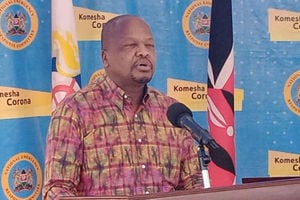This is how DNA test is carried out

Abbreviation for Deoxyribo Nucleic Acid test, DNA exam can be simply defined as the scientific matching of genetic profiles of unidentified or dead person with those of identified persons (dead or living). FILE PHOTO | NATION MEDIA GROUP
What you need to know:
- Abbreviation for Deoxyribo Nucleic Acid test, DNA exam can be simply defined as the scientific matching of genetic profiles of unidentified or dead person with those of identified persons (dead or living).
- Besides identifying people, it can be used to diagnose or rule out suspected genetic disorders, predict risks for specific conditions, or gain information that can be used to customise medical treatments.
The family of former Prime Minister Raila Odinga is set to conduct a DNA test to establish the paternity of twins his wife Ida claims were fathered by their late son Fidel.
The Odingas are the latest to turn to this scientific method of unravelling mysteries of parentage, ancestry and human identity.
Abbreviation for Deoxyribo Nucleic Acid test, DNA exam can be simply defined as the scientific matching of genetic profiles of unidentified or dead person with those of identified persons (dead or living).
Known as forensic examination of human remains, the investigation is done establish the person’s identity, and cause and manner of death.
Besides identifying people, it can be used to diagnose or rule out suspected genetic disorders, predict risks for specific conditions, or gain information that can be used to customise medical treatments.
WHY DNA TESTING
Genetic tests can also be carried out on plants and animals to establish their origins and diagnose genetic disorders.
DNA tests were recently used to identify the remains of 157 victims of March 10 Ethiopian crash, who included 32 Kenyans.
Identification of human remains is important for both legal and humanitarian reasons. This way, they can have a proper burial, families can get answers, death certificates can be issued and justice can be served.
The forensic identification of human remains is a legal determination— sealed by the jurisdictional authority’s signature on a death certificate.
Identification requires a holistic approach that takes into consideration all available scientific and contextual evidence.
Each line of evidence must be weighed and treated on its merits. The scale of the identification project must also be considered and the identification strategy adjusted accordingly.
So, how is DNA test to identify bodies done?
A typical DNA test follows the following procedure:
Identification and selection of DNA sample donors. The samples are usually taken from members of the deceased/unidentified person’s direct family — father, mother, children, brother or sister.
The samples may include bits of muscle tissue, bone tissue or dental elements (front teeth or molars). Samples from direct family members are preferred because they have a higher degree of similarity than the distant ones.
- Personal belongings containing DNA that was left on them by the victims before they died are also taken. These may include tooth brushes, hair brushes or razor blades.
- Experts take DNA samples from the victim to be identified.
- To identify a victim, DNA profiles of the victims are compared with the DNA profiles of their relatives and/or the DNA profiles made on the basis of their personal belongings.
A computer generated programme is then used to make a comparison and calculation for each body or body part of the victims and determines whether the DNA profile fits the DNA profiles of the relatives.
The computer-generated programme also compares the DNA profiles of the bodies and body parts of the victims with each other, to determine whether the body parts belong to the same victim and whether there is a family relationship between victims.
- The results are usually given in the form of percentages, with the lowest being 0 and the highest 99.99. For purposes of Fidel’s paternity DNA test, he will be declared the father of the twins if the test returns between 90 and 99.99 percent match.
- The cost of genetic testing can range from Sh20,000 to more than Sh200,000 depending on the complexity of the test, number of samples involved and availability of facilities in your area.
Report by Elizabeth Merab, Maureen Kakah and Harry Misiko.

